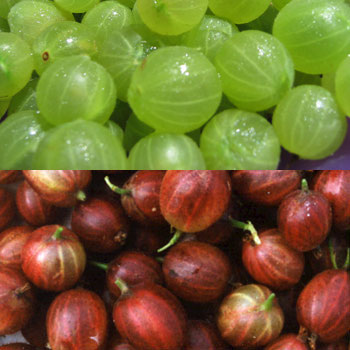
Gooseberries in the forest garden
 On a less experimental note, I ordered two
gooseberry bushes. Gooseberries and currants (both in the genus Ribes)
are some of the best plants for forest gardening since they are able to
bear fruit in partial shade. Ever since last winter when I read
the second volume of the Edible
Forest Gardens
book, I've been trying to decide between digging up a native currant I
found in the woods or buying a named cultivar. After reading this
Virginia
Extension factsheet on currants and gooseberries, I chose the
latter.
On a less experimental note, I ordered two
gooseberry bushes. Gooseberries and currants (both in the genus Ribes)
are some of the best plants for forest gardening since they are able to
bear fruit in partial shade. Ever since last winter when I read
the second volume of the Edible
Forest Gardens
book, I've been trying to decide between digging up a native currant I
found in the woods or buying a named cultivar. After reading this
Virginia
Extension factsheet on currants and gooseberries, I chose the
latter.
Gooseberries are best for fresh eating, which is how I prefer my fruit, as opposed to currants that are best cooked. There are two
different kinds of gooseberries (very much like there
are two kinds of cultivated grapes)
--- the European gooseberries tend to keel over here unless you spray
them with chemicals while the American ones do well here but may not be
as tasty. Newer varieties combine the best of both worlds.
I decided to try an improved American variety (Poorman), and a European
variety with good disease-resistance (Invicta.)
 There is one downside to the Ribes
genus --- some serve as an alternate host to the white pine blister
rust that decimates commercial plantings of white pine. As a
result, most gooseberries and currants were eradicated in the U.S. in
the 1900s before people realized that only the European black currant (Ribes nigrum) was really serving as
an alternate host to the rust. Now, many states outlaw planting
all Ribes species while other
states only outlaw the black currant. Here in Virginia, you can't
plant Ribes nigrum
except for varieties that have been bred to resist the rust, but you
can plant other gooseberries and currants with no problems. I
chose Indiana Berry to get my
two bushes from since the nursery has a good selection of varieties
that are supposed to do well in Virginia, and has the lowest prices I
could find once you add on shipping.
There is one downside to the Ribes
genus --- some serve as an alternate host to the white pine blister
rust that decimates commercial plantings of white pine. As a
result, most gooseberries and currants were eradicated in the U.S. in
the 1900s before people realized that only the European black currant (Ribes nigrum) was really serving as
an alternate host to the rust. Now, many states outlaw planting
all Ribes species while other
states only outlaw the black currant. Here in Virginia, you can't
plant Ribes nigrum
except for varieties that have been bred to resist the rust, but you
can plant other gooseberries and currants with no problems. I
chose Indiana Berry to get my
two bushes from since the nursery has a good selection of varieties
that are supposed to do well in Virginia, and has the lowest prices I
could find once you add on shipping.
| This post is part of our Splurging on Perennials lunchtime series.
Read all of the entries: |
Want more in-depth information? Browse through our books.
Or explore more posts by date or by subject.
About us: Anna Hess and Mark Hamilton spent over a decade living self-sufficiently in the mountains of Virginia before moving north to start over from scratch in the foothills of Ohio. They've experimented with permaculture, no-till gardening, trailersteading, home-based microbusinesses and much more, writing about their adventures in both blogs and books.
Want to be notified when new comments are posted on this page? Click on the RSS button after you add a comment to subscribe to the comment feed, or simply check the box beside "email replies to me" while writing your comment.
